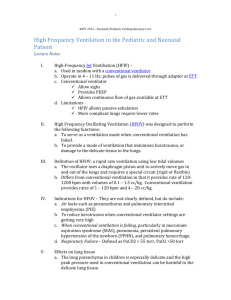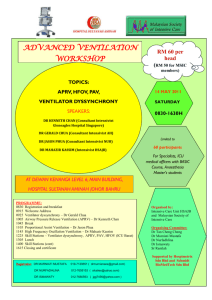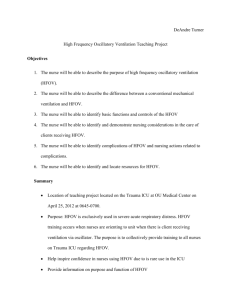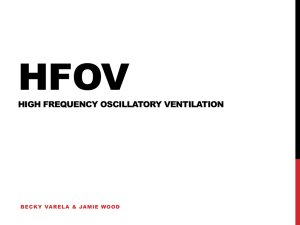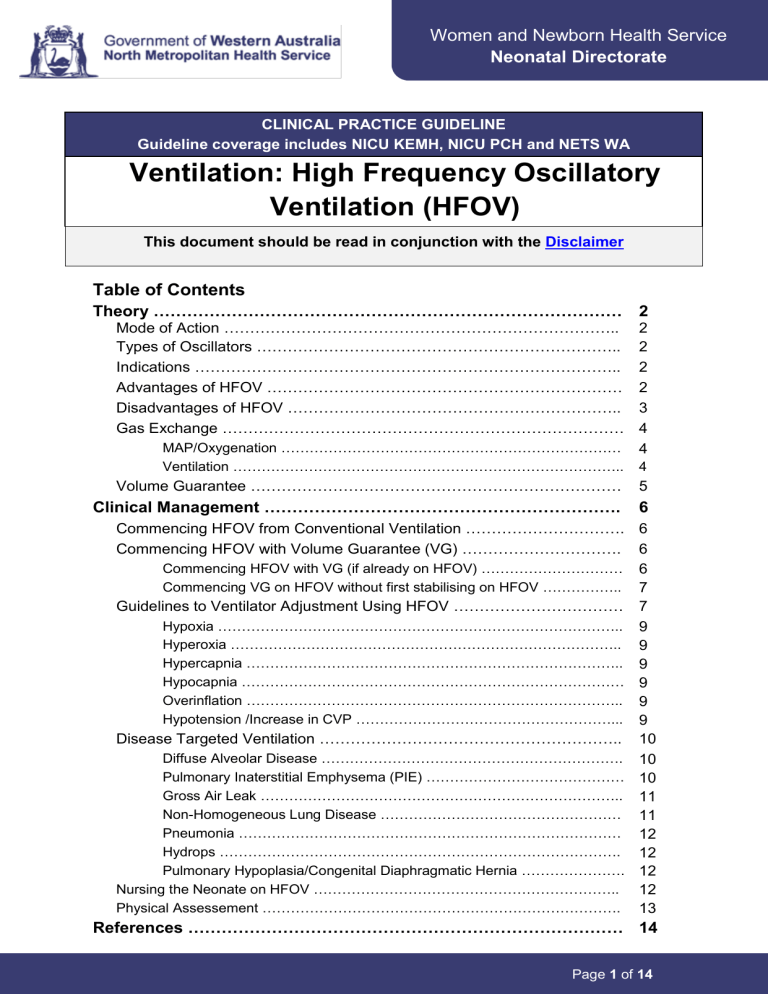
Women and Newborn Health Service Neonatal Directorate CLINICAL PRACTICE GUIDELINE Guideline coverage includes NICU KEMH, NICU PCH and NETS WA Ventilation: High Frequency Oscillatory Ventilation (HFOV) This document should be read in conjunction with the Disclaimer Table of Contents Theory ………………………………………………………………………… 2 Mode of Action ………………………………………………………………….. Types of Oscillators …………………………………………………………….. Indications ……………………………………………………………………….. Advantages of HFOV …………………………………………………………… Disadvantages of HFOV ……………………………………………………….. Gas Exchange …………………………………………………………………… MAP/Oxygenation ……………………………………………………………… Ventilation ……………………………………………………………………….. 2 2 2 2 3 4 4 4 Volume Guarantee ……………………………………………………………… 5 Clinical Management ………………………………………………………. 6 Commencing HFOV from Conventional Ventilation …………………………. 6 Commencing HFOV with Volume Guarantee (VG) …………………………. 6 Commencing HFOV with VG (if already on HFOV) ………………………… 6 Commencing VG on HFOV without first stabilising on HFOV …………….. 7 Guidelines to Ventilator Adjustment Using HFOV …………………………… 7 Hypoxia ………………………………………………………………………….. 9 Hyperoxia ……………………………………………………………………….. 9 Hypercapnia …………………………………………………………………….. 9 Hypocapnia ……………………………………………………………………… 9 Overinflation …………………………………………………………………….. 9 Hypotension /Increase in CVP ………………………………………………... 9 Disease Targeted Ventilation ………………………………………………….. 10 Diffuse Alveolar Disease ………………………………………………………. 10 Pulmonary Inaterstitial Emphysema (PIE) …………………………………… 10 Gross Air Leak ………………………………………………………………….. 11 Non-Homogeneous Lung Disease …………………………………………… 11 Pneumonia ……………………………………………………………………… 12 Hydrops …………………………………………………………………………. 12 Pulmonary Hypoplasia/Congenital Diaphragmatic Hernia …………………. 12 Nursing the Neonate on HFOV ……………………………………………………….. 12 Physical Assessement …………………………………………………………………. 13 References …………………………………………………………………… 14 Page 1 of 14 Ventilation: High Frequency Oscillation Ventilation Theory High Frequency Oscillation Ventilation (HFOV) uses tidal volumes that may be less than or equal to the anatomical dead space volume, potentially reducing cyclic (dynamic) volutrauma. The use of HFOV also facilitates gaseous exchange at lower peak distal (parenchymal) airway pressures than required during ventilation at conventional breathing frequencies, theoretically reducing the risk of barotrauma. Breaths are delivered by a vibrating diaphragm that provides for both a positive inspiration and active exhalation. Applied appropriately, the continuous distending pressure assists recruitment and maintenance of an optimal lung volume. Mode of Action HFOV utilises a piston or diaphragm to produce oscillatory gas flows within the airway. These oscillatory gas flows result in small volumes of gas moving toward and away from the patient. A continuous gas (bias) flow delivers fresh O2 to the airway whilst allowing waste gas (CO2) to be removed. Lung volume is maintained above FRC by the use of a constant distending pressure determined by end-expiratory or mean airway pressure. Available ventilation frequencies on neonatal oscillators commonly range from 3-20 Hz. Some oscillators have adjustable I:E ratios (1:1 or 1:2). Proximal airway pressure, not alveolar pressure, is monitored by the ventilator. Types of Oscillators At PCH/KEMH there are three types of ventilators that can provide HFOV. Two hybrid ventilators that provide both HFOV and conventional ventilator modalities (Fabian and VN500) and the Sensormedics 3100A(SM), which is a stand-alone HFO ventilator. Both the Fabian and the VN500 provide a sinusoidal pressure wave-form. The SM3100A delivers a more square pressure waveform. Nitric oxide can be added to the circuit in all three ventilators. Indications Severe lung disease unresponsive to conventional ventilation - “rescue therapy”. Homogeneous (uniform) lung disease such as HMD. Can be used for: Pulmonary air leaks, pulmonary interstitial emphysema, pneumothorax, bronchopleural fistulas, and pneumopericardium (in general the HFJV may be a better option for significant air leak syndromes). Hypoplastic lung, diaphragmatic hernia. Persistent pulmonary hypertension (PPHN) – particularly if secondary to widespread alveolar atelectasis. Meconium aspiration. Advantages of HFOV HFOV is a highly efficient mode for removal of waste gas. Hence, HFOV may provide a safer option for ventilation of the infant with respiratory failure, through the more efficient removal of CO2 without exposing the infant to excessive ventilator pressures and/or cyclic tidal volumes. At any given lung volume and when using Neonatal Guideline Page 2 of 14 Ventilation: High Frequency Oscillation Ventilation high-frequencies (e.g., > 10 Hz), the ventilation can be adjusted relatively independent of oxygenation. Once lung volume is optimised, the lung volume can be maintained at a distending volume avoiding repeated shear stress associated with collapse and reinflation of alveoli. Applied correctly, HFOV: Promotes a focus on optimal lung volume recruitment, potentially reducing both barotrauma and volutrauma. Reduces the risk of both static and dynamic volutrauma of the more compliant alveoli. Reduces the risk of static atelectatrauma associated with poorly compliant alveoli. Prevents the propagation of lung injury by supporting adequate gas exchange with small tidal volumes (0.8-2 mL/kg). Improves ventilation/perfusion, decreases dead space volume, and maintains gas exchange with less lung injury. May improve cardiac status. Disadvantages of HFOV There is a steep learning curve to the correct use of HFOV. Inexpert users and those unfamiliar with the unique physiological principles of gas exchange and pulmonary physiology that apply to HFOV may inadvertently cause harm to the patient. HFOV should always be used under close supervision of a senior neonatal physician. Applied incorrectly or inappropriately, HFOV may: Impair cardiac function. Impaired cardiac function results if excessive distending pressures are used, causing cardiac compression, pulmonary over distension compressing pulmonary blood vessels and impeding pulmonary perfusion. These effects are exacerbated in the setting of limited cardiac reserve in the very sick neonate. Impede venous return as the relatively constant pleural pressure and minimal lung volume changes result in nearly constant (and often higher) intrathoracic pressure than used in conventional ventilation. May exacerbate gas-trapping and air-leak. Note: Gas trapping is generally not an issue during HFOV due to active expiratory phase, unless mean airway pressure is inappropriately low, when choke points can form in the airways preventing full expiration. Neonatal Guideline Page 3 of 14 Ventilation: High Frequency Oscillation Ventilation Gas Exchange MAP/Oxygenation Adjustment of mean airway pressure influences lung volume, allowing manipulation of oxygenation. Optimum MAP corresponds to an anteroposterior (A-P) chest film of 8 to 9 posterior ribs, depending on gestation. Manipulation of the tidal volume affects oxygenation when lungs are either over or under-inflated. Ventilation CO2 elimination during HFOV is proportional to f VT2. Hence despite using lower tidal volumes, HFOV is more efficient than conventional ventilation (in which CO2 removal is determined by minute volume – respiratory rate x VT). DCO2 (diffusion co-efficient of CO2) is the parameter that is used to describe the f VT2 product. DCO2 varies for every baby depending on weight, disease and oscillatory frequency. For any individual baby, the required DCO2 is relatively stable over a period of a few days. DCO2 requirements are lower, if the baby is breathing spontaneously and contributing to its own gas exchange. DCO2 of 60-80 mL2/kg2/s are required for the infant with minimal spontaneous breathing. DCO2 of 40-60 mL2/kg2/s are required for the infant with spontaneous breathing. The following table provides a guide to the expected DCO2 (mL2/kg2/s) required for infants at any given weight. Weight 0.5 1.0 2.0 3.0 2 2 DCO2 (mL /kg /s) 10 40 160 360 Tidal volume (VT) delivery during HFOV is strongly influenced by the internal diameter of the tracheal tube. When HFOV is used without volume guarantee, halving the tracheal tube internal diameter (e.g., due to secretions) will increase the resistance by 16 fold, and markedly reduce tidal volume. Small increases in resistance are also evident with longer tracheal tubes. Other factors that reduce tidal volume delivery when HFOV is used without volume guarantee include: Decreasing the oscillatory amplitude (delta P). Decreased lung compliance (especially when HFOV is used at lower ventilator frequencies). Changing I:E ratio from 1:1 to 1:2 (reduces the inspiratory time, hence decreases the time to deliver tidal volume to the lung). Increasing the frequency (which also reduces the absolute inspiratory time for any given I:E ratio, thus also decreasing the time to deliver tidal volume to the lung). Increase in airway resistance (as this increases the time constant, hence less tidal volume is delivered within the same inspiratory time). Neonatal Guideline Page 4 of 14 Ventilation: High Frequency Oscillation Ventilation Clinically, when HFOV is used without volume guarantee, tidal volume is altered in response to blood gas/TcpCO2 trends by adjusting: 1. Amplitude or Delta-P (most important) Primary manipulations in PaCO2 are achieved by altering the oscillatory pressure amplitude (or power). Increasing the amplitude increases the displacement of the diaphragm/piston, increasing the VT delivered to the patient, lowering the PaCO2. 2. Frequency (Hz) Lowering the frequency in HFOV increases the tidal volume (when there is a fixed I:E ratio), thereby lowering the PaCO2. However, as frequency decreases, the percentage of the oscillatory amplitude transmitted to the proximal airways increases. The frequency, at which this amplitude increases significantly, is influenced by the mechanical properties of the lung. The appropriate frequency is dependent on the disease being treated. As a general rule for the SM3100A, higher frequencies (12-15 Hz) are used for low compliance (e.g. HMD), whilst lower frequencies (8-10 Hz) are used in the presence of high resistance (e.g. early phase meconium aspiration, CLD). Smaller babies with poorly compliant lungs require higher frequencies than more mature infants. Hybrid ventilators may have limited capacity to achieve required tidal volumes at high frequencies, in the absence of spontaneous breathing. It may be necessary to use lower frequencies in hybrid ventilators than previously selected when using the SM3100A. In general, the highest frequency achievable should be used, to reduce the risk of barotrauma when using HFOV mode in hybrid ventilators. 3. % I-Time I:E ratio is generally set at 1:2 for the Fabian and VN500, or 33 % (% inspiratory time) on the SM3100A. Increasing the I:E ratio to 1:1 (Fabian, VN500) or 50 % inspiratory time (SM3100A) may improve CO2 elimination at any given frequency. Increasing the absolute inspiratory time in this manner, permits more tidal volume to be delivered. Volume Guarantee Volume guarantee with HFOV (HFOV-VG) is available on the VN500 and Fabian ventilators. Volume guarantee is not available on the SM3100A. HFOV-VG allows the clinician to set a predefined tidal volume, irrespective of other ventilator variables such as frequency and inspiratory to expiratory ratio, or the mechanical properties of the airways and lungs. The clinician defines a maximum amplitude, and the ventilator will adjust the delivered amplitude as required (up to the predefined maximum amplitude) to achieve the set tidal volume. There are substantial theoretical benefits of using VG during HFOV to maintain more consistent and stable arterial PaCO2, and hence also more stable cerebral blood flow. HFOV-VG may be particularly advantageous in clinical situations where resistance or compliance is likely to be changing such as with secretions (increasing resistance) or during lung volume optimisation (changing compliance) or surfactant administration (initial increased resistance followed by increased compliance). The use of HFOV-VG is supported by one small RCT in improving stability of PaCO2. When using HFOV with VG, the clinician needs to remember that the delivered tidal volume will stay reasonably constant as frequency is changed (unless the performance limitations of the ventilation are reached at higher frequencies). Hence, unless the clinician decreases the set tidal volume to maintain a constant DCO 2 as Neonatal Guideline Page 5 of 14 Ventilation: High Frequency Oscillation Ventilation frequency is increased (or vice-versa if frequency is being decreased), the baby will develop instability in their gas exchange (resulting in either marked overventilation or under ventilation depending on the direction of the frequency change. Changing I:E ratio in HFOV with volume-guarantee will have no effect on the delivered tidal volume (but will alter the delta P required to achieve that tidal volume). Examples of approximate tidal volumes required at different frequencies are shown in the table below: Frequency (Hz) 5 10 15 VT (mL/kg) 2.8 2.0 1.6 Clinical Management The goal of HFOV is to maintain lungs in the optimal part of the compliance hysteresis curve (open lung strategy) to provide adequate oxygenation and ventilation. To switch to HFOV from CMV consider: Current Mean Airway Pressure (MAP) and CMV settings. Inflation of Lung fields. Disease Pathology - will determine the strategy used with HFOV. Commencing HFOV from Conventional Ventilation Read mean airway pressure on CMV. Set MAP as ordered (usually 2-3 cmH2O above conventional MAP if using an I:E ratio of 1:2 for hyaline membrane disease/diffuse atelectasis). May require lung opening/recruitment manoeuvres once started on infant. Set oscillatory frequency as ordered according to patient age and disease pathology (usually between 8-15 Hz). Increase amplitude until infant’s chest wall is visibly vibrating (rough starting place x 1.5-2 MAP depending on frequency – higher amplitude at higher frequency). Where possible place TcM for TcpCO2 monitoring. Assess lung inflation with a chest X-ray 30 to 60 minutes after commencing HFO. Optimal lung inflation correlates with obtaining an 8 to 9 posterior rib level expansion (8-8.5 ribs for extreme preterm, 8.5 – 9 ribs for more mature infants). Commencing HFOV with Volume Guarantee Commencing HFOV with VG (if already on HFOV) Start HFOV without VG based on above guide. Must start TcM monitoring and check accuracy prior to starting. Once a steady state has been reached with stable TcpCO2 in target range then: Record the VT and amplitude that is being given by ventilator. Set VG at the VT provided by the ventilator. Set amplitude limit ~20% above the amplitude currently used. If ventilator alarming VG low then review patient to see if there has been a change in clinical state or disease process (lung derecruitment, worsening Neonatal Guideline Page 6 of 14 Ventilation: High Frequency Oscillation Ventilation disease, pneumothorax etc.). Clinical review by senior clinician prior to further increases in the amplitude limit. Commencing Volume Guarantee on HFOV without first stabilising on HFOV Start VG based on table below. Frequency Lower limit (ml/kg) 5 2.8 7.5 2.3 10 2.0 12.5 1.8 15 1.6 Upper limit (mL/kg) 3.5 2.7 2.5 2.35 2.0 Must start TcM monitoring and check accuracy prior to starting VG. Adjust VG to achieve appropriate level of chest wiggle for the patient you are treating. Review TcM every 10 minutes initially. If TcpCO2 is: Below target range for infant then reduce VG by a maximum 10 %. (Note, because of HFOV efficiency, you may see very rapid change in the TcpCO2. Start with small changes then increase if no effect. Stay by the bedside initially to observe and monitor response). Above target range for infant then increase VG by a maximum of 10% (may need to increase amplitude limit). Again – stay by the bedside initially, as the change in TcpCO2 may be very rapid (1-2 minutes). Once infant is sitting in target range then monitor trend with TcMs. Guidelines to Ventilator Adjustment Using HFOV Keep Bias Flow as low as possible to achieve MAP (i.e. can be reduced from 20 L/min to ~12 L/min) for the SM3100A. Increase Bias Flow if infant is showing signs of air hunger. Aim for optimal lung inflation using the open lung strategy. MAP is increased during the initial volume recruitment phase until optimal oxygenation is reached, or until signs of reduced cardiac output (tachycardia, reduced blood pressure). During the initial optimisation phase, changes in MAP may need to occur every 10 minutes in order to avoid prolonged periods of atelectasis. During subsequent treatment, 3060 minutes should be allowed between changes in MAP to assess effect. MAP is not reduced until FiO2 is at < 0.6 (unless signs of over inflation). MAP should then be decreased in steps, until FiO2 requirements increase (Volume Optimisation). A useful algorithm for first intention HFOV in HMD is shown below: Neonatal Guideline Page 7 of 14 Ventilation: High Frequency Oscillation Ventilation De Jaegere A et al Neonatal Guideline Page 8 of 14 Ventilation: High Frequency Oscillation Ventilation Observe the delta P during lung volume optimisation. At any given frequency, the delta P will be lowest at the point of optimal lung volume. PaCO2 is the best indicator of the adequacy of the tidal volume. CXR may be needed after the recruitment to assess lung volume. In-line suctioning is preferred, to minimise the amount of lung collapse and the period before lung volume is re-established. If infant does not tolerate suctioning well then increasing the MAP during and after suctioning may be required to maintain lung volume. Hypoxia Increase FiO2 followed by increase in MAP up to maximum 25 cmH2O (if CVP does not increase) as required to decrease FiO2 back to 0.3 – 0.4. Increase bias flow if necessary to achieve the higher MAPs. Note: over distension of lungs may reduce gas transfer as well as cardiac output, thus once HFOV is commenced/in use, reducing MAP is often a more prudent initial response to hypoxia than an increase in MAP that may cause further over distension and clinical compromise. Hyperoxia Reduce FiO2 to keep SaO2 in target range. Consider decreasing MAP if FiO2 is < 0.3 – 0.4. Hypercapnia Increase amplitude or delta P (or VG if on HFOV+VG). Decrease frequency (however this may be accompanied by increased barotrauma, and should be reserved for high resistance diseases). Consider increase I:E ratio from 1:2 to 1:1 Ensure lung expansion is optimised: hypercapnia may result from atelectasis, or over distension. Hypocapnia Decrease amplitude. Increase frequency. Decrease I:E ratio from 1:1 to 1:2. Overinflation Reduce MAP. Consider lower frequency if very marked PIE. Consider change to HFJV. Hypotension / Increase in CVP Reduce MAP. Consider a change in ventilation: HFJV if efficient gas exchange is essential. Conventional ventilation if infant is breathing spontaneously and does not have high ventilator requirements. Volume expansion may be required. Dopamine/Dobutamine may be considered if over distension is not present. Neonatal Guideline Page 9 of 14 Ventilation: High Frequency Oscillation Ventilation Disease Targeted Ventilation Diffuse Alveolar Disease (I.e. Hyaline Membrane Disease/Respiratory Distress Syndrome, pneumonia, pulmonary haemorrhage and acute hypoxic respiratory failure due to a homogeneous lung disease process) The goal is to recruit gas exchange surface area by opening alveoli and increasing lung volume, without compromising cardiac function and avoiding barotrauma. In the Preterm Infant MAP is started 2-3 cmH2O above that on CMV, but must be sufficient enough to inflate the lungs (i.e. with complete white-out and stiff lungs, may require a much higher MAP). Lung volume recruitment manoeuvre (note: if following the algorithm above, you may start at a lower MAP but changes in MAP occur every 1-2 minutes until lung volume optimisation is achieved). Aggressive weaning of MAP as lung volume and compliance improve. Frequency ranges from 12-15 Hz (Generally start at 12 Hz for < 1000 gm, and 15 Hz for infants < 750 gm). The amplitude is set to achieve an appropriate amount of chest wall movement, but is titrated to the desired PaCO2. The delta P required is defined by frequency: a higher delta P at the airway opening is required for higher frequencies (but this does not equate to higher oscillatory pressures in the lung – usually the reverse is true, as the ventilation becomes more efficient as frequency increases and the extent of damping of the pressure waveform also increases with increasing frequency). Use a percent IT of 33 % (SM3100A) or I:E ratio of 1:2 unless instructed to do differently by the consultant neonatologist. If adequate PaCO2 is not achieved with the max amplitude, the I:E ratio may be increased to 1:1, or frequency is decreased to increase the tidal volume (and vice versa for over ventilation). May apply infrequent (1 per minute) sustained inflations to improve lung volume (e.g., IMV breaths on the Fabian or VN500), providing pulsatile periods of increased pressure during oscillation to re-expand atelectatic alveoli and to bring the lung onto the deflation limb of the pressure volume curve. Discuss the PIP and inspiratory time of the sustained inflation with the consultant neonatologist. Term and Near Term Infant MAP commences 2-4 cmH2O greater than that on CMV. Frequency of 10-12 Hz; on Fabian and VN500 may require lower frequencies (6-10 Hz) Set amplitude as above. Pulmonary Interstitial Emphysema (PIE) With air-leak syndromes, the goal of optimising alveolar surface area is reduced to allow for resolution of the air leak syndrome, resulting in temporary adequate but likely sub-optimal oxygenation and ventilation. Allow elevated PaCO2 levels but with pH > 7.25. MAP should be set equal to, or slightly less than that on CMV. Neonatal Guideline Page 10 of 14 Ventilation: High Frequency Oscillation Ventilation Frequency at 10-15 Hz. Amplitude set to achieve minimal chest wall movement required to achieve desired PaCO2. The use of low oscillatory pressure amplitudes (c/w PIP or CMV) often leads to resolution of the air-leak without requiring great reductions in MAP. In those with severe air-leak/PIE, continuation of HFOV for 24-48 hours after the resolution of the leak is sometimes recommended (to allow complete resorption of interstitial air). In cystic air-trapping, use a MAP ≈ to that used on CMV and accept low arterial PaO2 and high PaCO2 and gradually increase in small increments. Weaning MAP is given priority over FiO2 in those with large cysts. In those who’s PIE fails to improve, wean back to IMV after FiO2 is reduced to 0.5 and PIP< 30 cmH2O (sometimes associated with mobilisation of pulmonary oedema and clearance of airway secretions). Gross Air Leak Consider HFJV for gross air leak. “The Low Pressure Approach”. Initial MAP is dependent on the volume of the non-air leak lung, which needs to be normalised to attain adequate gas exchange. If atelectasis occurs in the good lung, a minimal leak may have to be accepted while re-opening the lung. In the Preterm Infant MAP is set 1 cmH2O above that on CMV. Frequency 10-15 Hz depending on the patient’s size. Amplitude as before. Term and Near Term Infant (2 categories) 1. Air-leak with adequate inflation: MAP to equal that on CMV. Frequency of 10 Hz. Amplitude as above. 2. Air-leak with poor inflation: MAP set 1-2 cmH2O higher than that on CMV. Frequency of 10 Hz. Non-Homogeneous Lung Disease Most often Meconium Aspiration Syndrome (amniotic fluid aspiration, ARDS, pneumonia). Any strategy that is effective in opening damaged areas may result in overinflation and trauma to more normal areas of the lung. Focal gas-trapping may be worsened by HFO and result in airway rupture and pneumothorax. Less responsive than in diffuse homogeneous lung disease especially if there is marked gas-trapping. Allow MAP to equal that on CMV initially, and then volume recruit. Frequency 6-10 Hz is required to overcome some of the airway obstruction and associated high resistance present with this pathology, also allows for greater elimination of CO2. Neonatal Guideline Page 11 of 14 Ventilation: High Frequency Oscillation Ventilation Amplitude as above. The most severely affected lung is placed in the dependent position to increase resistance to gas delivery to that lung. Avoid sustained inflations. After the first 24 hours in meconium aspiration syndrome, chemical pneumonitis develops and poor compliance may become more important than increased resistance. In this instance, it is worth considering an increase in frequency after the first 24 hours. Pneumonia Set MAP initially at 1 cmH2O above that on IMV. Frequency at 10-15 Hz (use lower frequencies if a viral pneumonia with significant airway involvement). Amplitude as above. Hydrops MAP initially same as that on CMV and then gradually increased to achieve maximum oxygen saturation (at risk of lung injury). If still poor oxygenation at 5-6 cmH2O greater than CMV, re-check X-ray for lung volume, and position. Frequency at 10-15 Hz. Amplitude as above. Pulmonary Hypoplasia/Congenital Diaphragmatic Hernia MAP initially started at equal or greater than that on CMV, depending on the contra-lateral lung. Start in the 10-12 cmH2O range and increase in 1 cmH2O increments to optimise inflation of the unaffected lung. Be aware of cardiac function when increasing MAP, as the mediastinum may be shifted from its optimal position compromising cardiac output, as well as existing PPHN. Frequency 10 Hz. Amplitude as above. Nursing the Neonate on HFOV Ensure bullet port in situ on HFO tubing. Due to rigid tubing, more attention to ETT position is needed to prevent accidental dislodgment and excess pressure on nasal tissues. Use of the plastic block on the side edge of the warmer enables more stability of the tubing. Every time the tubing is disconnected consider brief (max 5 min) increase in mean airway pressure of 1-2 cmH2O. Neonate is nursed on a warmer or incubator, with a sheepskin, initially in the supine position. Do not muscle relax unless requested to do so by a consultant. Babies can (and should) have spontaneous gentle breathing on HFOV. Continuous TcM is usually required with the site rotated every 3 hours, to continuously observe trends in PaO2 and PaCO2 without need excessive blood gases. Pre and post ductal oxygen saturations may be required if PPHN is present. Monitor ABG’s closely, especially 20-30 minutes after a ventilation parameter change. Neonatal Guideline Page 12 of 14 Ventilation: High Frequency Oscillation Ventilation Delta P and DCO2 need to be documented as well as the ventilation settings hourly if on VN500 or Fabian ventilator. Any sudden change in DCO2 needs a medical review. On VG mode extra documentation is needed as per table below. Ventilation mode Prescription Documentation HFO ± VG HFO ± VG FiO2 MAP MAP MAP Amp ΔP (is achieved amplitude) If not in VG-mode Amp VThf * DCO2*(will fluctuate a bit) If in VG-mode Ampl max Ampl max ΔP* (achieved amplitude) VT Set VT and set VT/Kg VT*(achieved) DCO2 (should be relatively stable) * only on VN500/Fabian ventilators Physical and Airway Assessment Visual assessment includes activity, posture, behavioural state, chest wall vibration (indicates tidal volume) and symmetry. Chest wall vibration will be affected by the diameter of the ETT, mucous plugging and ETT displacement. A change in the magnitude of chest wall vibration in the absence of alteration in the oscillatory parameters should be investigated immediately. Respiratory rate cannot be measured by the ventilator (but spontaneous respiratory rate can be counted manually). Auscultation of heart tones, breath sounds and bowel sounds can be achieved by briefly interrupting the oscillation (CPAP will be maintained). Breath sounds can be assessed during oscillation to note air entry and symmetry of oscillatory intensity. Changes in pitch or rhythm of delivered breaths, may indicate changes in ETT position or need for suctioning. Suction should only be performed when absolutely necessary and is not required routinely for HFOV. Frequent, even temporary disconnections are discouraged as this results in immediate loss of alveolar recruitment, hence in-line suctioning should be used. Periods of disconnection should be minimised. It may be necessary to temporarily increase MAP (20 % for 2 minutes) to re-recruit lung volume if indicated by deterioration in arterial oxygen saturations post-suctioning. Consider assessing and documenting pain scores. Neonatal Guideline Page 13 of 14 Ventilation: High Frequency Oscillation Ventilation Resources High-Frequency Oscilatory Ventilation: Theory and Practical Applications References De Jaegere A et al, Am J Respir Crit Care Med. 2006; 174:639-45 Document owner: Neonatal Directorate Management Committee Author / Reviewer: Neonatal Directorate Management Committee Date first issued: December 2012 Last reviewed: 28th December 2018 Next review date: 28th December 2021 Endorsed by: Neonatal Directorate Management Committee Date endorsed: 22nd January 2019 Standards Applicable: NSQHS Standards: 1 Governance Printed or personally saved electronic copies of this document are considered uncontrolled. Access the current version from the WNHS website. Neonatal Guideline Page 14 of 14
